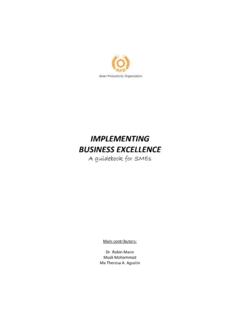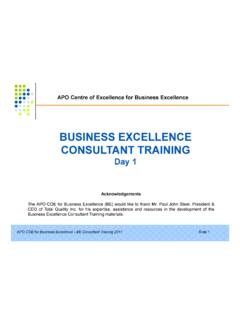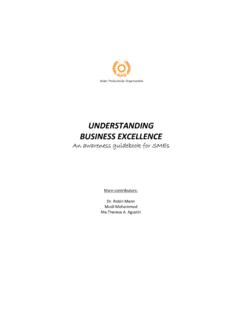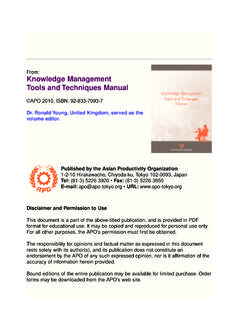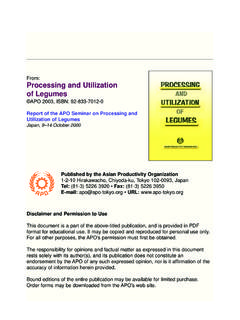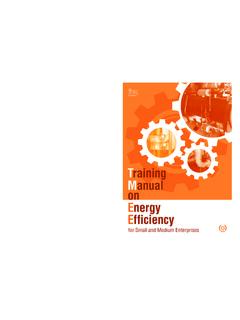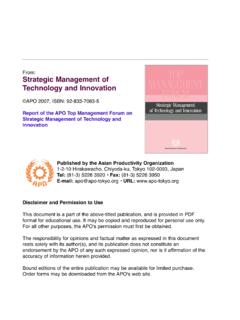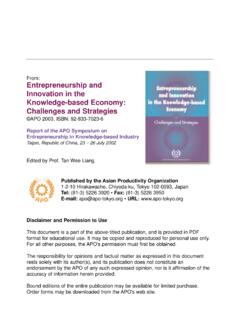Transcription of Six Sigma for Quality and Productivity Promotion - …
1 Productivity Series 32 From:Six Sigma for Qualityand ProductivityPromotion APO 2003, ISBN: 92-833-1722-Xby Sung H. ParkPublished by the Asian Productivity Organization1-2-10 Hirakawacho, Chiyoda-ku, Tokyo 102-0093, JapanTel: (81-3) 5226 3920 Fax: (81-3) 5226 3950E-mail: URL: and Permission to UseThis publication is provided in PDF format for educational use. Itmay be copied and reproduced for personal use only. For allother purposes, the APO's permission must first be responsibility for opinions and factual matter as expressed inthis document rests solely with its author(s), and its publicationdoes not constitute an endorsement by the APO of any suchexpressed opinion, nor is it affirmation of the accuracy of informa-tion herein editions of the publication may be available for limited pur-chase. Order forms may be downloaded from the APO's web Productivity ORGANIZATIONFOR Quality AND Productivity PROMOTIONP roductivity Series 32 Sung H.
2 ParkSIX SIGMA2003 ASIAN Productivity ORGANIZATIONFOR Quality AND Productivity PROMOTIONSung H. ParkSIX Sigma Asian Productivity Organization, 2003 ISBN: 92-833-1722-XThe opinions expressed in this publication do not necessarily reflect theofficial view of the APO. For reproduction of the contents in part or infull, the APO s prior permission is OF CONTENTSP reface ..v1. Six Sigma What is Six Sigma ? .. Why is Six Sigma Fascinating? .. Key Concepts of Management .. Measurement of Process Performance .. Relationship between Quality and Productivity . 272. Six Sigma Five Elements of the Six Sigma Framework .. Top-level Management Commitment and Stakeholder Involvement .. Training Scheme and Measurement System .. DMAIC Process .. Project Team Activities .. Design for Six Sigma .
3 Transactional/Service Six Sigma .. 483. Six Sigma Experiences and Motorola: The Cradle of Six Sigma .. General Electric: The Missionary of Six Sigma .. Asea Brown Boveri: First European Company to Succeed with Six Sigma .. Samsung SDI: A Leader of Six Sigma in Korea .. Digital Appliance Company of LG Electronics:Success Story with Six Sigma .. 67i4. Basic QC and Six Sigma The 7 QC Tools .. Process Flowchart and Process Mapping .. Quality Function Deployment (QFD) .. Hypothesis Testing .. Correlation and Regression .. Design of Experiments (DOE) .. Failure Modes and Effects Analysis (FMEA) .. 112 Balanced Scorecard (BSC) .. 1185. Six Sigma and Other Management Quality Cost and Six Sigma .. TQM and Six Sigma .. ISO 9000 Series and Six Sigma .
4 Lean Manufacturing and Six Sigma .. National Quality Awards and Six Sigma .. 1346. Further Issues for Implementation of Six Sigma Seven Steps for Six Sigma Introduction .. IT, DT and Six Sigma .. Knowledge Management and Six Sigma .. Six Sigma for e-business .. Seven-step Roadmap for Six Sigma Implementation .. 147iiSix Sigma for Quality and Productivity Promotion7. Practical Questions in Implementing Six Is Six Sigma Right for Us Now? .. How Should We Initate Our Efforts forSix Sigma ? .. Does Six Sigma Apply Well to Service Industries? .. What is a Good Black Belt Course? .. What are the Keys for Six Sigma Success? .. What is the Main Criticism of Six Sigma ? .. 1628. Case Studies of Six Sigma Improvement Manufacturing Applications:Microwave Oven Leakage.
5 Non-manufacturing Applications: Development of an Efficient Computerized Control System .. R&D Applications: Design Optimization of Inner Shield of Omega CPT .. 178 AppendicesTable of Acronyms .. 187A-1 Standard Normal Distribution Table .. 189A-2 t-distribution Table of t(f;a) .. 190A-3 F-distribution Table of F(f1, f2;a) .. 191A-4 Control Limits for Various Control Charts .. 195A-5 GE Quality 2000: A Dream with a Great Plan .. 196 References .. 200 Index ..203 Table of ContentsiiiPREFACEThis book has been written primarily for company managersand engineers in Asia who wish to grasp Six Sigma concepts,methodologies, and tools for Quality and Productivity promotionin their companies. However, this book will also be of interest toresearchers, Quality and Productivity specialists, public sectoremployees, students and other professionals with an interest inquality management in general.
6 I have been actively involved over the last 20 years in indus-trial statistics and Quality management teaching and consultationas a professor and as a private consultant. Six Sigma was recent-ly introduced into Korea around 1997, and I have found that SixSigma is extremely effective for Quality and Productivity innova-tion in Korean companies. I have written two books on SixSigma in Korean; one titled The Theory and Practice of SixSigma, and the other called Design for Six Sigma , which areboth best-sellers in Korea. In 2001, I had the honor of beinginvited to the Symposium on Concept and Management of SixSigma for Productivity Improvement sponsored by the AsianProductivity Organization (APO) during 7 9 August as an invit-ed speaker. I met many practitioners from 15 Asian countries,and I was very much inspired and motivated by their enthusiasmand desire to learn Six Sigma .
7 Subsequently, Dr. Mochtan,Program Officer of the Research & Planning Department, APO,came to me with an offer to write a book on Six Sigma as anAPO publication. I gladly accepted his offer, because I wanted toshare my experiences of Six Sigma with engineers andresearchers in Asian countries, and I also desired a greatimprovement in Quality and Productivity in Asian countries toattain global competitiveness in the world book has three main streams. The first is to introduce anoverview of Six Sigma , framework, and experiences (Chapters1 3). The second is to explain Six Sigma tools, other manage-ment initiatives and some practical issues related to Six Sigma (Chapters 4 6). The third is to discuss practical questions inimplementing Six Sigma and to present real case studies ofvimprovement projects (Chapters 7 8).
8 This book can be used asa textbook or a guideline for a Champion or Master Black Beltcourse in Six Sigma training. I would like to thank Dr. Mochtan and DirectorYoshikuni Ohnishi of APO, who allowed me to write this bookas an APO publication. I very much appreciate the assistance ofProfessor Moon W. Suh at North Carolina State University whoexamined the manuscript in detail and greatly improved thereadability of the book. Great thanks should be given to Mr. HuiJ. Park and Mr. Bong G. Park, two of my doctoral students, forundertaking the lengthy task of MS word processing of the man-uscript. I would especially like to thank Dr. Dag Kroslid, aSwedish Six Sigma consultant, for inspiring me to write this bookand for valuable discussions on certain specific topics in thebook. Finally, I want to dedicate this book to God for giving me thenecessary energy, health, and inspiration to finish the manuscript.
9 ViSix Sigma for Quality and Productivity Promotion1. Six Sigma What is Six Sigma ? Sigma ( ) is a letter in the Greek alphabet that has becomethe statistical symbol and metric of process variation. Thesigma scale of measure is perfectly correlated to such charac-teristics as defects-per-unit, parts-per-million defectives, andthe probability of a failure. Six is the number of Sigma mea-sured in a process, when the variation around the target issuch that only outputs out of one million are defects underthe assumption that the process average may drift over thelong term by as much as standard deviations. Six Sigma may be defined in several ways. Tomkins (1997)defines Six Sigma to be a program aimed at the near-elimi-nation of defects from every product, process and transac-tion.
10 Harry (1998) defines Six Sigma to be a strategic ini-tiative to boost profitability, increase market share andimprove customer satisfaction through statistical tools thatcan lead to breakthrough quantum gains in Quality . Six Sigma was launched by Motorola in 1987. It was theresult of a series of changes in the Quality area starting in thelate 1970s, with ambitious ten-fold improvement drives. Thetop-level management along with CEO Robert Galvin devel-oped a concept called Six Sigma . After some internal pilotimplementations, Galvin, in 1987, formulated the goal of achieving Six- Sigma capability by 1992 in a memo to allMotorola employees (Bhote, 1989). The results in terms ofreduction in process variation were on-track and cost savingstotalled US$13 billion and improvement in labor productivityachieved 204% increase over the period 1987 1997(Losianowycz, 1999).
